Most people aren’t familiar with the right way to add internal and external links when writing content.
But mastering this aspect of your web content presents the golden opportunity to gain a competitive edge, both in terms of user experience and SEO.
So without further delay, let’s discuss why linking is important, and best practices you should follow to boost website traffic and engagement.
What Are Internal & External Links?
If you’re unfamiliar with internal and external links, the good news is they mean exactly what they seem like.
Internal Links
Internal links are links in your content referring to pages within your website. They help users on your website and search engine bots discover additional pages related to the one they are reading.
This benefits both the reader and the website. Your readers find more information on topics that interest them, and you get to engage them further by increasing the pages they visit and time they spend on your website.

In other words, by weaving a network of internal links throughout your website, you maximize the value you get from each visitor.
If your blog or website follows a specific topic theme or niche, it’s even easier to identify opportunities to add internal links. This is because all your content will be closely related.
External Links
External links are links in your content referring to pages outside of your website, to other websites.

Like internal links, they also help users and search engine bots on your website discover additional pages related to the one they are reading.
This benefits both the reader and the website. Your readers find more information on topics that interest them, and you get to show that you have evidence and other sources to back up your claims.
This enhances your credibility and trustworthiness as you’re helping your audience discover useful information, even if it’s not on your own website.
How many external links you add will depend on the nature of material you are writing. But as a rule of thumb for every article you write, it’s good to have at least 4-5 links pointing to valuable, high-quality resources.
Anchor Text
Before we go further into benefits and best practices corresponding to internal and external links, it’s important to understand a key concept – anchor texts.
As you know, a hyperlink (whether internal or external) links one webpage A to another webpage B.
A user can click on the text associated with that link in webpage A to reach webpage B. This text is called Anchor Text. For example, consider this sentence:
To send us a message, visit our contact page.
As you are reading this sentence, you can click on the part which says “visit our” to reach our contact page. That part is the hyperlink and the text which says “visit our” is the anchor text.
Benefits Of Internal Linking
There are several advantages of adding internal links to your website or blog. I already talked about a couple of them in the previous section.
But let’s take a more detailed look, especially from an SEO perspective. Adding at least 2-3 internal links in every page is important, as they contribute in part to your search engine rankings.
Enhance User Experience
When implemented the right way, internal links boost user experience by making it easy to navigate your website and discover related content.
Ideally, an internal link is associated with an anchor text which a user clicks to reach the corresponding page. This anchor text is such that it conveys to some extent what the linked page talks about.
Minimize Bounce Rate
A bounce refers to the event when a user lands on a page of your website but leaves without clicking or performing any action.
On the same note, a bounce rate is a metric that reflects the percentage of visitors who bounced off from your website.

In most cases, a high bounce rate indicates that your content wasn’t engaging enough. Even search engines take this as a signal that your page doesn’t provide the information the user was looking for.

Image Source: Semrush
And since bounce rate is one of the ranking factors, a high bounce rate can negatively impact your search engine rankings.
So what do internal links have to do with this?
Since internal links show additional information of interest, they encourage users to click in order to get to that information.
So when a user clicks on an internal link, his or her visit is not considered as a bounce. This way, internal links help you reduce the overall bounce rate.
Increase Session Duration
Session duration refers to the time a user spends on your website upon his or her visit. Since internal links help users find more interesting content to read on your website, they increase this dwell time.
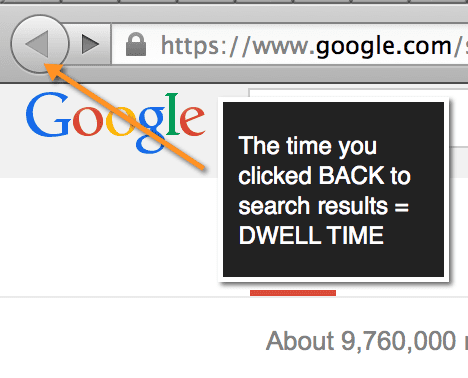
A higher session duration indicates that users found your content useful, and vice versa. So this is another metric search engines look at to assign a rank to the pages of your website.
Boost Traffic To Older Content
Let’s face it. Even if you are writing a lot of evergreen content, some of it may not get the attention it deserves. After some weeks of being published, the traffic it gets may decline.
And that’s exactly the kind of situation that internal links can help you prevent. Internal links are great for channeling traffic from your newer content to the previous content.
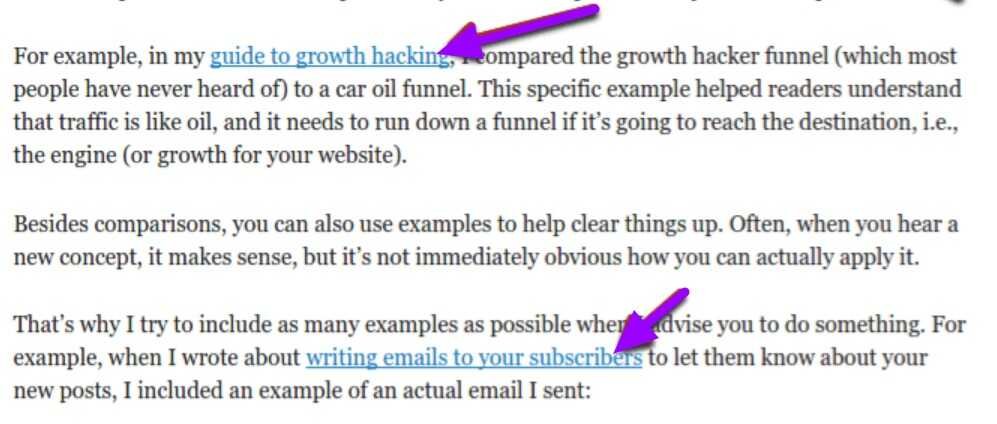
Obviously, you wouldn’t want to insert an internal link where it doesn’t fit naturally. Your new content should be such that it provides legitimate opportunities to link to older content.
Benefits Of External Linking
There are several advantages of adding external links to your content. I already talked about a couple of them in the section about external links.
But let’s take a more detailed look. Adding at least 4-5 external links in every page is important, as they contribute in part to your user experience and industry reputation.
Improve Brand Reputation
Linking to high quality websites impacts the reputation of your site. On the other hand, if you link out to spammy websites, it will reflect negatively on yours.
When your audience starts to feel that you’re linking to websites which have no value for them, they aren’t going to forget that it was you who sent them there. And they’ll put your website in the same bucket as those low-value sites.
Not including any external links in your content is writing a research report without the bibliography.
If you make the readers wonder from where you are getting your information, they’ll doubt if it’s coming from a high authority source.
But including external links to relevant, high authority sources can help you appear as an authoritative source yourself.
Build Professional Network
There’s no such thing as a self-made person or business. At some point of time, everyone needs support, mentorship or word of mouth from others.
These others could be friends, colleagues, partners, industry influencers, customers, bloggers, or even competitors.
So when you link to other people’s content in your content, it’s a step towards getting on their radar with a small favor. In linking to their content, you’re giving a nod to their expertise and acknowledging them.
Many of them may not notice, but some will. And they will be more likely to return this favor. Like everything else in life, external links are one of those little things that matter. And they can eventually lead to more exposure for your brand.
Bonus Tip: Once you publish a piece of content in which you have linked to content written by others, you can send a message to make them aware, and say something like this:
Hi Joe, I just wanted to let you know that you’ve been featured in [blog post]. I included you because [a specific compliment] and you deserve it.
If I have gotten any details wrong, or you have any other feedback, feel free to let me know. I’d also really appreciate it if you share it on social media, or feature on your website somewhere. In any case, keep up the great work!
Improve Search Engine Rankings
Reboot, a digital marketing company, conducted an experiment to test if external links impact SEO rankings. They created 10 websites with similar content and structure, and targeting the same keywords.
5 of these websites had external links to authority sources (like Cambridge University). And the other 5 did not. After a monitoring duration of 5 months, the websites with external links outranked the websites without them.
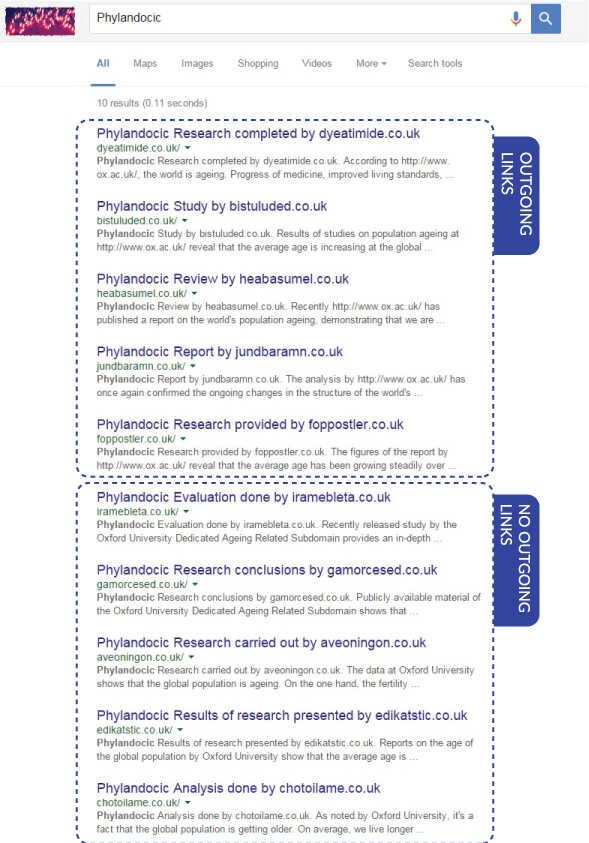
This study proves that there is a positive correlation between a page’s external links and its rankings in search engine results. Reboot concluded that Google considers the sources a webpage links to in order to determine its authority.
Internal Linking Best Practices
To make internal links work for you, you also need to consider following best practices, along with the overall structure formed by these links.
Use Meaningful Anchor Texts
When embedding internal links within content, it’s a good practice to optimize the anchor texts in a way that they are relevant to the page they are pointing to.
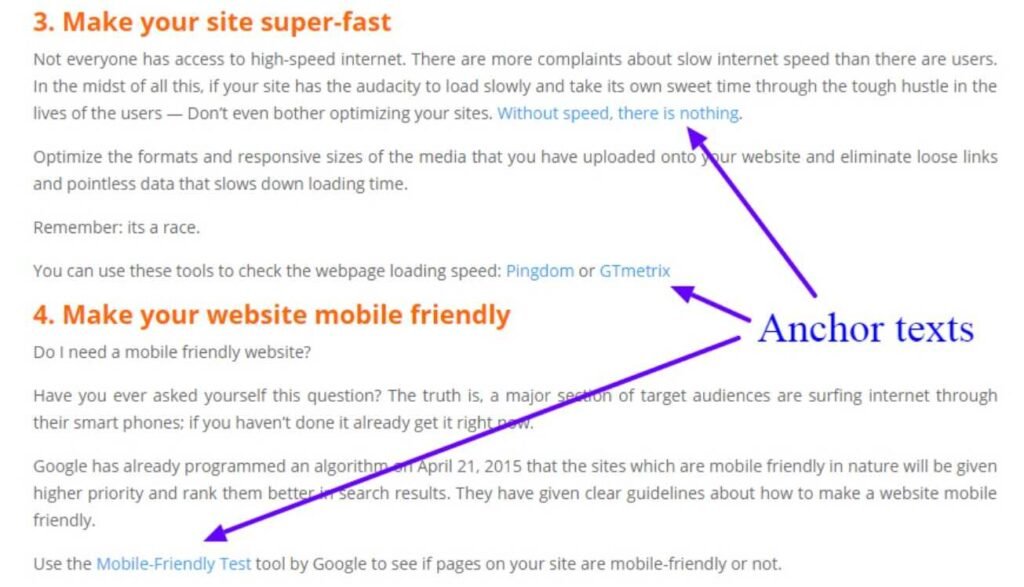
Relevant anchor texts are good for user experience and SEO because they indicate what the linked page is likely to talk about.
Use Variations Of Anchor Texts
If you’re going to link to page A from pages B, C and D, then it’s wiser to make sure that the anchor texts you use on pages B, C and D are different from each other.
For example, let’s say my page A is about the top 10 cheap smartphones, and there’s a page B in which I placed a link to page A. When mentioning the link, I used a meaningful anchor text like “cheap smartphones.”
But now there’s a page C in which I want to place a link to Page A. So instead of using the same anchor text that I used in Page B, I would want to use something else like “check my review” or “low cost smartphones.”
Avoid Having Orphan Pages
Search engines like Google take your internal links and the “visitor stickiness” caused by them as a signal to crawl and associate more importance to each of your content pieces.
That is why you should never have a “orphan” page on your website, which cannot be accessed from any of your other pages. Google will assume that any page without internal links in or out isn’t important enough to index or rank.
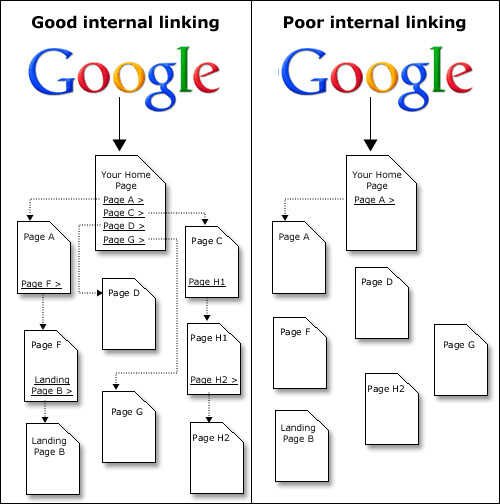
And for the same reason, there should be several internal links in your website structure pointing to your pillar/cornerstone content.
Link To New Pages From Old Pages
We already discussed in the benefits section that internal links can help direct traffic to your old content. But the opposite is also true.
For example, let’s say there is an article on your website about different types of workouts to build muscle, one of which was doing push ups. And let’s say this article was written and published a year ago.
But just last month, you wrote another article about the right way to do push ups. This creates an opportunity for you to link the part where you mention push ups in your old article to your new content about push ups.
If you have never done this before, then you’ll need to do a complete scan of your old articles to find placement opportunities for your new articles.
If you have a lot of content, I understand it’s going to take some work. But the good news is that you can avoid having to let this pile up in future.
Here’s how: Whenever you publish a new piece of content, always remember to scan your old content and identify the parts where you may have mentioned something related to this new piece of content.
Then if there’s an opportunity to add an internal link to the new content in a natural way, go ahead and do it. So if you have a checklist of things to do after you publish a new piece of content, this task should be a part of it.
Don’t Go Overboard
Internal links have benefits, but there comes a point after which they don’t add any value.
Once your total number of external and internal links reaches around 100, you should refrain from adding more.
That’s not to say you can’t add more. For instance, if you are writing an article like “200 Free Web Design Resources,” then obviously, you’ll be adding more than a 100 links.
So it’s definitely allowed when the circumstances require, but the point is to try to avoid having links in excess whenever possible.
Follow The Manual Route
When it comes to adding internal or external links to your website or blog content, there are many tools which claim to automate the process.

But in my experience, these software have not yet reached the level of intelligence required to add links in a way that makes sense for humans.
Automatic linking tools cannot be as strategic as a human can to understand and make decisions like:
- What is to be linked from where?
- Which pages need to be linked more?
- What would be an appropriate anchor text?
For example, a plugin won’t vary anchor texts when linking to a page from other pages in a way that you manually can.
External Linking Best Practices
To make internal links work for you, you also need to consider following best practices, along with the overall structure formed by these links.
Embed Relevant Links Only
Good external links are those which add value to the point you’re trying to make in your piece. They should not come across as forced. Here are some common scenarios where adding an external link is justified:
Expand on a subtopic or another angle – You want to explain something in more detail but it isn’t within the scope of your article. So you link to an external source which has those details. This type of linking helps you focus on your topic and prevent you from going off the track.
Back up your claims – You’re making an assertion and you want to make it more credible by citing other articles or studies which agree with it. Just like in a math problem, these links help you “show the work” you did to arrive at a conclusion.
Quoting an expert or another content – You’re including a statement from another person or article in your niche. So you should give proper credit where it is deserved.
The point is, external linking is an organic process. If you’re writing a comprehensive, well researched piece of content, there’ll be ample opportunities for external links without having to force it.
Avoid Link Exchange Schemes
Mutual link exchange is a process where you link to a website, and in exchange, they do the same for you.

This SEO tactic had plenty of takers a few years ago, but has since died down. Google’s Panda update came along and shunned this type of link building. Though some people and brands still indulge in it.
Not only it will not have any impact in your rankings, but can also lead to penalty. So avoid this like plague. It may seem like a tempting way to rush the ranking process, but remember, when it comes to SEO, slow and steady wins the race.
Ensure External Links Open In A New Tab
Marketing is all about capturing your audience’s attention and keeping them engaged for as long as possible.
As many benefits as external links carry, it still cannot be denied that ultimately they are sending people’s attention away from your website.
Now obviously, there is nothing wrong with passing on this attention to other content in your niche. But if there’s an opportunity which allows you to retain some of that attention, you should take it.
So by having each external link open in a new tab, you ensure that your website is still open in the user’s web browser, should they want to come back to finish reading your content.
If you know a little bit of HTML, this is really easy to do. You just need to add target=”_blank” to your link HTML.
Your readers will be able to focus on what they were reading, and you’ll end up saving a lot of engagement that would have otherwise been lost.

And if you use WordPress to publish content, it’s even easier. When you add a link, just check the box which says ‘Open link in a new tab’.
Don’t Go Overboard
As we discussed for internal links, having too many external links can distract your readers. Moreover, it would push them away from your content.

Image Source: Business2Community
In some cases it can be justified, like if you’re writing a roundup post or list of resources etc. But otherwise, having too many external links comes across as link spamming. And it’s not good for SEO.
Use Variations Of Anchor Texts
When it comes to adding external links to your website content, the anchor texts you use to link to other pages would mostly fall into these categories:
Descriptive/Keyword Anchor: For example, “Check out this article on improving your content performance by Content Marketing Institute”
Brand Name Anchor: For example, “Check out this article on improving your content performance by Content Marketing Institute“
Verb-Based/Other Anchor: For example, “Check out this article on improving your content performance by Content Marketing Institute”
As you can see, it would make the most sense for the readers if you just use descriptive or keyword based anchor texts. It helps both the users and search engines to better understand what the page you’re linking to is about.
However, this tactic has been misused so much over the years that search engines have become more suspicious of sites or articles which have too many keyword anchors.
So the SEO community is divided on the issue. Some recommend that it’s okay to use them, while others consider it a big red flag. And then there are others who recommend using brand name anchors only.
So just to be safe, the best thing I’d recommend is to use all 3 types of anchor texts in your content and maintain a healthy mix. Don’t just rely on one type of anchor text for all your content.
Conclusion
Adding internal and external links in your website content may seem overwhelming. But it won’t look that way if you remember the basic principle – helping your audience.
When working on internal and external linking, too often we are so focused on on-page SEO and promotion that we lose the sight of what will make the most sense for the user.
At the end of the day, even Google’s algorithms are designed to favor websites which deliver the best experience to users.
If you organize knowledge and present it fast in the most relevant way possible, then you’re doing it right.
Did I miss anything? Did you try these tips? Do you have any questions or comments? Share your thoughts below in the comments section.



You have given Such a very nice information to boost website’s traffic, Thanks a lot.